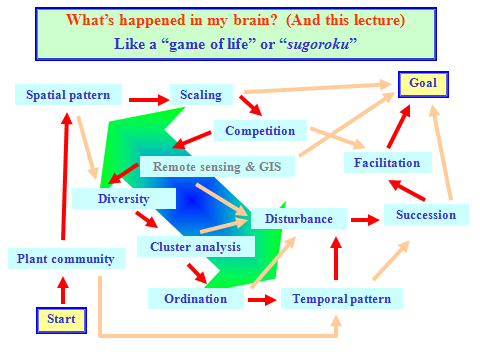(Upload on December 29 2025) [ 日本語 | English ]
Mount Usu / Sarobetsu post-mined peatland
From left: Crater basin in 1986 and 2006. Cottongrass / Daylily
Version for graduate students
Room# C204-2 (every Tuesday and Friday in the first half of second semester, 13:00-14:30)
|
 Expected background: Knowing "fundamental ecology" and/or related subjects
Expected background: Knowing "fundamental ecology" and/or related subjects |
October 7 2025What is this lecture?Flow chart of this lecture Classification of ecology Life cycle (life history)
Case of Trillium (Ref. T. kamtschaticum) |
Case: Trillium in fragmented forests Metapopulation
Case: Silver-studded blue butterfly (Plejebus argus) in North Wales |
|
Ecosystem (or biosystem) Environment Definitions and criteria of plant community
Flora (floristic composition) - Ex. Mount Koma October 10 2025
Larch forest in Oku-Nikko The problems on pattern and scale in ecology Complex dynamics in ecology
Toposequence, chronosequence, and permanent plot October 14 2025Scaling from large to smallScale-dependent factor Scale-dependent interactions
Scale-dependent interactions and community structure on cobble beaches |
Global (biome) > Regional > Habitat > Microhabitat
Biome: Precipitation and temperature WorldPlant functional types (PFTs) and species attributes Inductive method vs deductive method October 17 2025 (canceled)October 21 2025Biodiversity hotspotsJapan Climate (temperature and precipitation)
Distribution of ferns in Japan Distribution of Sasa (dwarf bamboo) in Hokkaido MicrohabitatCase 1. Pumice Plains on MSH: rill, near-rock Case 2. Tussock Case 3. Flooding Case 4. Tree establishment on Mount Usu: rill, ground surface texture |
October 24 2025Natural disturbance and human disturbanceScale, frequency and intensity Natural disturbance Floodplain
Case study: Vegetation zonation in Sorachi River Human disturbance Biological invasion Alien species Invasive species - biological invasion Invasion patterns of larch (Larix kaempferi) on Mount Koma
Seed source vs environmental factors (elevation, aspect and slope) October 28 2025Intermediate (-disturbance) hypothesis
Gause's axiom
Cases: Alpine zone, and volcano |
Estimation of root biomass
The role of duff on seedling establishment Distribution and dispersion Random, contagious, and regular distribution patterns Age and dispersion pattern Analysis methods on spatial pattern
Dispersion pattern analysis October 31 2025Competition: intera-specific and inter-specific competition
Competition experiment design Competition for light causes plant biodiversity loss after eutrophication November 7 2025Indices of plant-plant competition
On indices of plant-plant competition and their pitfalls Environmental gradients, biotic interactions, and disturbance |
|
Principles: distance from mother land and island size
Mother land
Corridor in landscape |
Corridor supports the movements of animals and plants November 7 2025Restoration ecologyManagement methods for degraded ecosystemsLand degradation Terminology used in the analysis of ecosystem stability Landscape ecologyLandscape unit: structure, function, and changeSatoyama (village forest) |
|
alpha;-diversity, β-diversity, and γ-diversity
α-diversity = within-habitat diversity
Type 0: Using number of species = Species richness Fischer's α-diversity index - Representative T1 How to measure α-diversity Shannon-Wiener diversity index (H') - representative T2 |
Diversity and evenness True diversitySelection of parameter for diversity Density vs biomass 'Correlation' vs 'causal relation'β-diversity (between-habitat diversity) November 11 2025
Types of similarity index
Diamond graph |
|
Main purposes of multivariate analysis
Classification and ordination Clsutering or cluster analysis
Divisive strategy vs agglomerative strategy Agglomerative strategy
From 'single linkage method' to 'Average linkage method'
Average linkage method
Principle Other clustering methods Ordination: Indirect and direct ordinationIndirect ordination |
November 14 2025
Polar ordination (PO) Application of DCA to investigate vegeation development patterns after peat mining Principal component analysis (PCA)
Eigenvalue and eigenvector Application of PCA on fern development Canonical correspondence analysisPrinciples and applications of CCA on the relationship between seedbank and standing vegetation |
In this term (anterior half in second term 2025), your scores are graded based on the reports. The reporting assignment is described below. 今期(2025年後期前半)は、レポートにより評価を行う。そのレポート課題は、以下の通り。
|
|